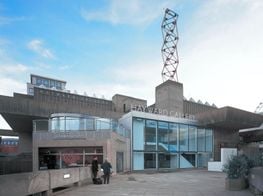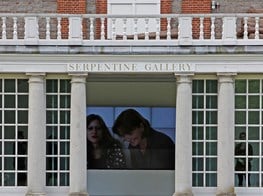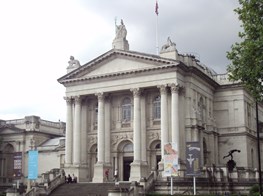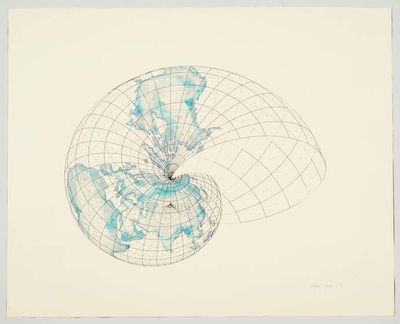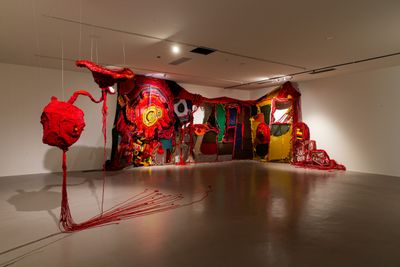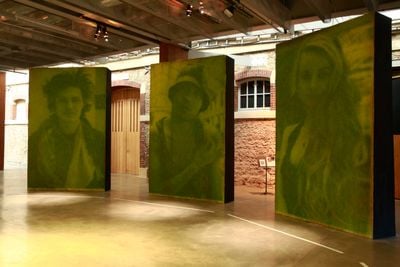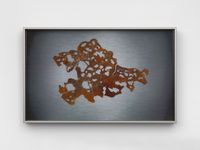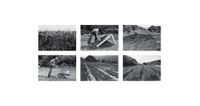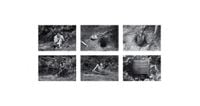What Is the Art World Doing About Climate Change?
Climate activists have repeatedly targeted museums in recent years. In London, the Hayward, the Serpentine, and the Tate have responded with exhibitions and initiatives addressing the climate crisis.
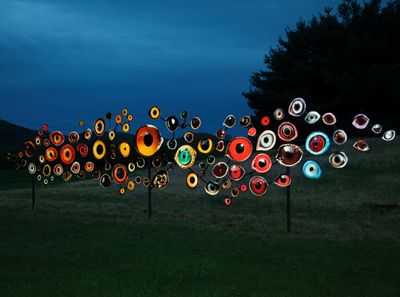
Jenny Kendler, Birds Watching I (2018). Printed reflective film mounted on aluminium on steel frame. 270 x 1220 x 20 cm. Courtesy the artist.
Environmental issues are a hot topic in London this summer. Mayor Sadiq Khan is expanding the controversial Ultra-Low-Emission Zone to address the city's air pollution, while Just Stop Oil creates headlines protesting fossil fuels at museums and cultural events.
Conversations about climate have ricocheted across the capital and landed firmly in the offices of London's contemporary art institutions, many of which are taking matters into their own hands.
This month, the Hayward Gallery at Southbank Centre will open Dear Earth: Art and Hope in a Time of Crisis (21 June–3 September). The show includes works by 15 contemporary artists responding to the climate emergency.
For this expansive exhibition, the Hayward has looked to different generations of eco-artists, ranging from pioneers like Hungarian-American environmental artist Agnes Denes to newcomers such as Brazilian indigenous rights activist and artist Daiara Tukano.
Dear Earth hinges on the practice of Brussels-based Nigerian artist Otobong Nkanga, which is rooted in the natural world and the ways communities relate to it. Nkanga has proposed that 'caring is a form of resistance'. It's from this proposition that the show draws its inspiration.
According to the Hayward's Chief Curator, Rachel Thomas, 'this exhibition really looks at a renewed sense of connection with the natural world and invites audiences to consider the unique involvement and role that art has to play in the climate debate. It is a hopeful and compassionate way to look at the climate and to look at our planet, our dear Earth.'
Dear Earth acts as the flagship event for the Southbank Centre's seasonal programme Planet Summer, which advocates for a communal response to the climate emergency. The series includes performances, parties, and talks with activists like Greta Thunberg.
There will also be artistic interventions, including works like activist banners by Ed Hall, flags by Lucy McLauchlan signalling the Thames' rising water levels, and kennardphillips' oil rig version of the Andrew Wyeth painting Christina's World (1948).
This multifaceted programme is reminiscent of Serpentine Gallery's ongoing Back to Earth series, which last year featured a major group exhibition, live performances, films screenings, talks, public art installations, and publications, all asking the question: how can art respond to the climate emergency?
While artists and curators are increasingly addressing climate issues through their work, institutions have also acknowledged a need for changes to how they operate.
'An exhibition or programme that is thematically devised on this premise [of the climate emergency], which then runs its course and a box is ticked, is simply not enough', said Kostas Stasinopoulos, Curator, Live Programmes at the Serpentine.
He explained that art institutions need to show 'a real sense of dedication and responsibility so that it becomes systemic in the sense that change becomes structural and long-term.'
'I'd like to see more institutions and other agents within the art world be more rigorous about ways to move forward that are premised on honesty and accountability,' Stasinopoulos urged, 'which will ultimately liberate stalemates often felt when one does not take ownership of how entangled these issues are, or is afraid to acknowledge that we can no longer work as singularities when the whole ecosystem is on fire.'
An important first step for institutions was cutting ties with polluting sponsors. The British Museum will soon end its 27-year sponsorship with oil giant BP, as reported earlier this month by The Guardian. Tate ended its BP sponsorship in 2017, after 26 years.
Tate, the Serpentine, and the Hayward Gallery have also signed onto the Gallery Climate Coalition, whose members include over 800 artists, collectives, galleries, and institutions around the world. They have committed to reducing emissions based on a 2021 study by the UK environmental charity Julie's Bicycle, which found the art world's total global carbon footprint to be approximately 70 million tonnes of CO2e per annum. The sector will need to reduce emissions by at least half before 2030 to match the international commitment to a 1.5°C warming limit.
Additionally, institutions are hiring for new positions devoted to the climate emergency.
Contact Lucia Pietroiusti launched the General Ecology project at the Serpentine in 2018. She's now Head of Ecologies at the Serpentine, which aims to 'coalesce a coherent vision and strategy for the organisation's dedication to the environment, and then act accordingly', extending from artistic programming to operational actions like reducing emissions.
She said, 'hiring a position that has a mandate to look after environmental questions is a crucial first step towards making those profound transformations that we're striving for.'
Tate has put out their own call for an Adjunct Curator, Art & Ecologies who will be tasked with facilitating environmental justice and raising awareness of the climate emergency through the museum's collection and programming. The role has yet to be filled.
Ultimately, Pietroiusti said transparency and accountability will be key to the art world's response to climate change.
'When threatened, an organisation (and an organism) tends to become more anxious, more defensive, to put up barriers rather than break them down,' she said. 'What would happen if we just gently and lovingly began to peel those barriers away, and we showed each other the cards in our hands, our fears and shames, with humility?' —[O]


